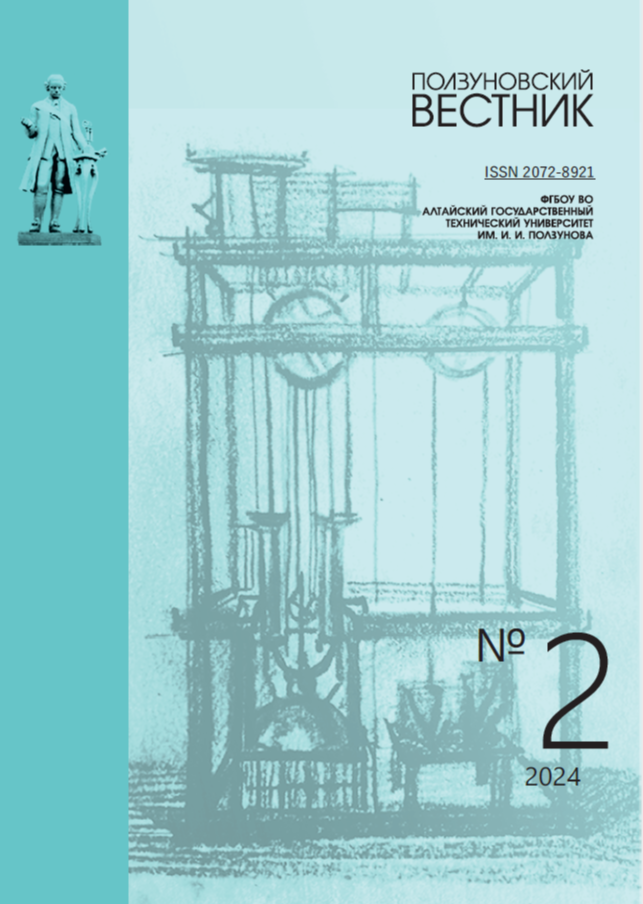STUDY OF QUALITATIVE CHARACTERISTICS MULTICOMPONENT MIXTURES FOR BISCUITS
KQYSIK
DOI:
https://doi.org/10.25712/ASTU.2072-8921.2024.02.019Abstract
The results of studies of the effect of psyllium as a source of dietary fiber on the qualitative characteristics of multicomponent mixtures for biscuits are presented. It was found that the introduction of 1-7% psyllium instead of a part of premium wheat flour increases the content of dietary fiber in multicomponent mixtures by 1.2-2.7 times. A pronounced negative effect of psyllium on the color and whiteness of multicomponent mixtures has been recorded, which imposes a restriction on the use of this component in mixtures in an amount exceeding 5% instead of part of the flour. The effect of psyllium on the mass fraction of moisture and acidity of multicomponent mixtures has not been detected. The relaxation of the protein-proteinase complex of multicomponent mixtures has been proven: when using psyllium as a prescription ingredient of mixtures over 3%, gluten falls into the category of "non-washable". The addition of 1-7% psyllium increases the number of drops and the water absorption capacity of multicomponent mixtures by 6-27% and 4-11%, respectively, relative to the control sample. The development of prototypes of biscuits made it possible to establish the possibility and expediency of using a multicomponent mixture with 5% psyllium in their production: the obtained samples had a regular shape, a smooth surface with noticeable inclusions of gray and brown, the appearance in the fracture was layered, with equal porosity, without blisters, hardening and traces of non-kneading, taste and smell characteristic for this type of product. The mass fraction of moisture, acidity, alkalinity of biscuits with psyllium did not differ from these quality indicators of the control sample baked without an enriching additive. The use of psyllium made it possible to improve the structure of products, which naturally increased the thickness of biscuits and the wetness of finished products.
References
Хайруллин В.А., Терехов И.Г., Шакирова Э.В. Население российской Арктики: численность, процессы, прогнозы // Науковедение. 2013. № 5. (18). С. 1–24.
Tokarev S.A. & Buganov A.A. (2007). Evaluation and prognosis of non-infectious risk in children in dependence on age and period of living in the Far North. Alaska Med. Vol. 49, (2). 142–144. (In Russ.).
Alaska Obesity Facts Report 2014. Alaska : Governor Department of Health and Social Services, May 2014. 13–14. (In Russ.).
Sharma S. & Barr A.B. & Macdonald H.M. [et al.]. (2011). Vitamin D deficiency and disease risk among aboriginal Arctic population. Nutr. Rev. Vol. 69, (8). 468‒478. (In Russ.).
Попов В.Г., Белина С.А., Федорова О.С. Раз-витие технологии производства специализированных продуктов питания для населения Арктики // Ползуновский вестник. 2017. № 3. С. 4‒18.
Разработка рецептуры комплексной пищевой физиологически функциональной системы с целью получения специализированных продуктов питания для населения Арктики / В.Г. Попов [и др.] // Ползуновский вестник. 2019. № 1. С. 90-95 doi: 10.25712/ASTU. 2072-8921.2019.01.017.
Изучение питания, антропометрических показателей и состава тела у коренного и пришлого населения российской Арктики / А.К. Батурин [и др.] // Вопросы питания. 2017. Т. 86. № 5. С. 11‒16.
Краснова И.С., Семенов Г.В., Гучок Ж.Л. Ки-сломолочные сублимированные продукты питания для населения, работающего в условиях Крайнего Севера // Российская Арктика. 2022. № 19. С. 61‒67. doi: 10.24412/2658-4255-2022-4-61-67.
Пищевая ценность национальных молочных продуктов с добавлением лесных ягод и дикорастущих пищевых растений Якутии / У.М. Лебедева [и др.] // Вопросы питания. 2015. Т. 84. С. 132-140. doi: 10.24411/0042-8833-2015-00071.
Морские водоросли как важный функциональный ингредиент и продовольственное сырье для обогащения рационов питания населения Арктической зоны Российской Федерации / О.А. Шепелева [и др.] // Журнал медико-биологических исследований. 2021. Т. 12. № 1. С. 99‒113. doi: 10.37482/2687-1491-Z180.
Заворохина Н.В., Феофилактова О.В. Разработка адаптогенных напитков для снижения холодового стресса у жителей Крайнего Севера // Технологии пищевой и перерабатывающей промышленности. АПК – продукты здорового питания. 2022. № 3. С. 93‒100. DOI 10.24412/2311-6447-2022-3-93-100.
Karomatov I.D. & Saidov К.О. Herb plantain block // Biologiyava integral tibbiyot. 2018. С. 226‒235.
Роль пищевых волокон в коррекции пищева-рения и запоров различной этиологии / Е.Ю. Плотникова [и др.] // Медицинский совет. 2019. № 14. С. 99‒106. doi: 10.21518/2079-701X-2019-14-99-106.
ГОСТ 9404-88. Мука и отруби. Метод определения влажности : введ. 1990-01-01. Москва, 2007, 5 с.
ГОСТ 26361-2013. Мука. Метод определения белизны : введ. 2014-07-01. Москва, 2014, 19 с.
ГОСТ 27493-87. Мука и отруби. Метод определения кислотности по болтушке : введ. 1989-01-01. Москва, 2007, 4 с.
ГОСТ 27558-87. Мука и отруби. Методы определения цвета, запаха, вкуса и хруста : введ. 1989-01-01. Москва, 2007, 4 с.
ГОСТ 27839-2013. Мука пшеничная. Методы определения количества и качества клейковины : введ. 1990-01-01. Москва, 2007, 9 с.
ГОСТ ISO 3093-2016. Зерно и продукты его переработки. Определение числа падения методом Хагберга-Пертена : введ. 2017-07-01. Москва, 2019. 16 с.
ГОСТ 5897-90. Изделия кондитерские. Методы определения органолептических показателей качества, размеров, массы нетто и составных частей : введ.1992-01-01. Москва, 2012. 8 с.
ГОСТ 5898-2022. Изделия кондитерские. Методы определения кислотности и щелочности : введ.2023-01-01. Москва, 2022. 17 с.
ГОСТ 5900-2014. Изделия кондитерские. Методы определения влаги и сухих веществ : введ. 2016-07-01. Москва, 2019. 14 с.
ГОСТ 10114-80. Изделия кондитерские муч-ные. Метод определения намокаемости : введ. 2017-07-01. Москва, 2019. 16 с.
Downloads
Published
How to Cite
Issue
Section
License
Copyright (c) 2024 Alexandra S. Zakharova, Svetlana I. Koneva

This work is licensed under a Creative Commons Attribution 4.0 International License.















 .
. This work is licensed under a
This work is licensed under a 
